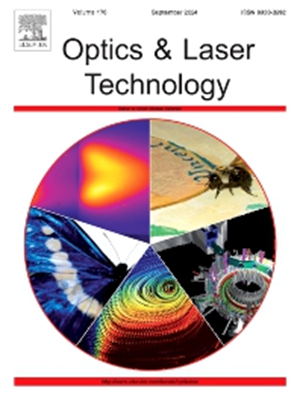Nanoimprint replication of laser-induced ripples for encoder applications
IF 4.6
2区 物理与天体物理
Q1 OPTICS
引用次数: 0
Abstract
Laser-induced periodic surface structures (LIPSS) offer unique optical properties as dark marking which is applicable for optical encoders, but their direct laser fabrication is costly and slow. This study introduces a cost-effective and scalable alternative: thermal nanoimprint replication of LIPSS onto flexible, metallized polyethylene terephthalate (PET) film. LIPSS were initially fabricated on stainless steel using picosecond laser ablation and then replicated onto aluminum-coated PET film via thermal nanoimprinting at varying temperatures. Atomic force microscopy confirmed successful replication, with optimal fidelity achieved at 180 °C, preserving the ca. 450 nm periodicity of the LIPSS while transferring ripple heights from 114 nm in steel master to 80 nm in PET replica. Reflectance measurements using UV–Vis-NIR spectroscopy and focused laser beam reflection demonstrated significant contrast between rippled and not rippled areas on the PET film, comparable to the steel master and sufficient for optical encoder applications. Frequency domain analysis of focused laser reflectance scans confirmed consistent periodicity in both master and replica. These results demonstrate that thermal nanoimprint is a viable, scalable, and cost-effective technique for replicating LIPSS onto flexible substrates, enabling the production of high-contrast optical encoder scales for various sensing and positioning applications.
求助全文
约1分钟内获得全文
求助全文
来源期刊
CiteScore
8.50
自引率
10.00%
发文量
1060
审稿时长
3.4 months
期刊介绍:
Optics & Laser Technology aims to provide a vehicle for the publication of a broad range of high quality research and review papers in those fields of scientific and engineering research appertaining to the development and application of the technology of optics and lasers. Papers describing original work in these areas are submitted to rigorous refereeing prior to acceptance for publication.
The scope of Optics & Laser Technology encompasses, but is not restricted to, the following areas:
•development in all types of lasers
•developments in optoelectronic devices and photonics
•developments in new photonics and optical concepts
•developments in conventional optics, optical instruments and components
•techniques of optical metrology, including interferometry and optical fibre sensors
•LIDAR and other non-contact optical measurement techniques, including optical methods in heat and fluid flow
•applications of lasers to materials processing, optical NDT display (including holography) and optical communication
•research and development in the field of laser safety including studies of hazards resulting from the applications of lasers (laser safety, hazards of laser fume)
•developments in optical computing and optical information processing
•developments in new optical materials
•developments in new optical characterization methods and techniques
•developments in quantum optics
•developments in light assisted micro and nanofabrication methods and techniques
•developments in nanophotonics and biophotonics
•developments in imaging processing and systems

 求助内容:
求助内容: 应助结果提醒方式:
应助结果提醒方式:


